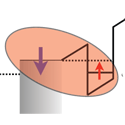Kondo effect lights up
As one of the few tractable problems in many-body physics, the Kondo problem—the interaction between an impurity spin and a surrounding sea of conduction electrons—has been a staple of condensed matter theory and experiment. First observed in the 1930s as an anomalous increase in the low-temperature resistance of metals embedded with magnetic atoms and understood only three decades later (many theorists contributed, some more than Kondo), the Kondo effect attracted renewed interest with its realization in quantum dots.
Optical spectroscopy may again breathe fresh air into this problem. In a paper appearing in Physical Review Letters, Hakan Türeci at Princeton University and colleagues in the US and Europe present calculations, connected to experiments to be published elsewhere, that ask: How does the many-body Kondo state evolve when the interaction is turned on (or off) rapidly with light?
The authors assume a semiconductor quantum dot coupled, by tunneling contacts, to a Fermionic reservoir. Initially, the electrons on the quantum dot have a net spin of zero, but laser light tuned to the right frequency can excite an electron into the conduction band of the quantum dot that interacts with the electrons in the reservoir.
The ability to rapidly turn the Kondo effect on with light offers a unique way to explore the so-called Anderson orthogonality catastrophe—a prediction about how violently the quantum many-body state of the electronic reservoir changes in response to a sudden change in the scattering potential (in this case, the spin). Signatures of this “catastrophe” are visible in the tails of the optical absorption line shape and, according to Türeci et al.’s calculations, should be tunable with a magnetic field. – Jessica Thomas





